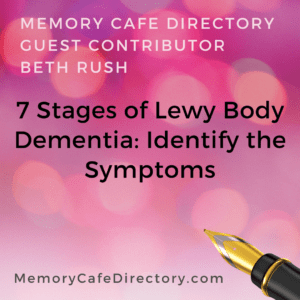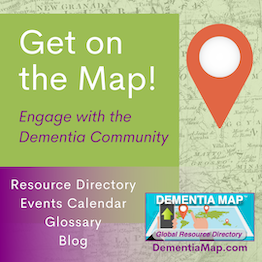Memory Cafe Directory posts and/or links to retailers can be advertising, sponsored, or affiliate links. We may earn a small commission from them. Thank you.
Lewy body dementia is a subcategory within the broader illness of dementia, which consists of impaired memory, cognitive function and decision-making that interferes with daily activities. It is one of the most common forms of dementia.
Just like other types of this disease, Lewy body dementia has different stages of severity that help doctors with the diagnostic and treatment process.
What are the seven stages of Lewy body dementia? What are the various symptoms of each, and how should patients and family members respond? Here’s everything you need to know about Lewy body dementia’s cause, symptoms, stages and treatment methods.
What Makes Lewy Body Dementia Unique?
Lewy body dementia (LBD) is the second-most common form of dementia after Alzheimer’s disease. It’s unique because it affects your cognitive functioning more than other types of dementia. Alzheimer’s largely causes memory issues and Parkinson’s disease affects motor functioning.
The reason why LBD can cause significant cognitive decline is the presence of abnormal protein deposits called Lewy bodies. Alpha-synuclein is the main ingredient in these deposits. It normally helps neurons transmit electrical impulses, but people with LBD start growing excessive amounts that slowly deteriorate the regions responsible for thinking, memory and movement.
In contrast, people with Alzheimer’s disease develop beta-amyloid clumps that cause abnormal chemical changes in the brain’s tau proteins. Tau is a crucial protein that stabilizes the internal structure of nerve cells. Excessive beta-amyloid clumps force the tau proteins to tangle up, which blocks synaptic communication between neurons. Regardless of the type, these abnormal deposits of a protein substantially impacts quality of life.
People with LBD may also have tau protein tangles, but alpha-synuclein is the key ingredient to remember. This slight neurochemical difference causes LBD to have a wider range of symptoms than Alzheimer’s or Parkinson’s. As a result, the disease worsens more quickly. Recent studies have shown that patients only survive an average of five to eight years after the symptoms start.
LBD Symptoms and Risk Factors
Lewy body dementia patients can exhibit many mental, behavioral and physical symptoms affecting everyday tasks. These are the most common symptoms observed by family members and medical professionals:
Cognitive Decline
People with LBD experience a decline in many cognitive abilities in daily life similar to those of Alzheimer’s disease, including memory problems, confusion, disorientation and poor problem-solving skills.
Impaired Movement
LBD patients experience impaired movement like those with Parkinson’s disease, including slow reaction times, rigid joints, muscle spasms, poor hand-eye coordination and a shuffling walk.
Deregulation of Body Functions
LBD impacts the autonomic nervous system, which causes the deregulation of essential functions like digestion, bowel control, perspiration, heart rate and blood pressure.
Hallucinations
People with LBD often experience visual hallucinations such as shapes, people and animals that aren’t there. The hallucinations may also include sounds, smells or touching sensations.
Trouble Sleeping
Rapid eye movement (REM) sleep behavior disorder is a common illness accompanying LBD, causing patients to move and speak while they sleep. They can take a long time falling into a deep sleep as a result.
Lewy body dementia usually appears in the same demographic as other forms of the disease — adults 65+ years old with a family history of dementia. Recent studies have shown that one in 10 older Americans has clinically diagnosed dementia, while 22% of older Americans experience mild cognitive impairment.
What Are the 7 Stages of Lewy Body Dementia?
After a patient is diagnosed with LBD through a brain scan or additional detailed memory tests, medical professionals determine the dementia’s severity. Although most people receive a diagnosis in the early stages of dementia, sometimes the disease goes undiagnosed until the symptoms are moderate to severe. Here’s a full breakdown of the seven stages of LBD.
Stage 1 — No Cognitive Symptoms
The first stage of LBD has no observable symptoms, and the patient’s behavior has not yet changed. Even experienced caregivers of older patients usually don’t notice stage one of Lewy body dementia. The only way to confirm the diagnosis is through brain imaging — either a CT or MRI scan.
Early diagnosis of LBD is important because it allows the patient to play an active role in future planning while their mental faculties are still close to 100%. Family members can educate themselves about future symptoms and prepare a new living situation if necessary. Most importantly, early diagnosis gives everyone more time to process the news in a healthy way.
Stage 2 — Very Mild Cognitive Decline
The second stage is also difficult to spot because the symptoms may overlap with normal human behaviors. Patients will have brief lapses in memory, failing to remember names, a common phone number, places, and objects they should be familiar with. However, every older adult experiences mild forgetfulness from time to time, so the patient’s family doesn’t always suspect mild dementia is the culprit.
People with stage two LBD may also show a slight physical decline, struggling to get around the house or complete daily tasks. Once again, families often blame these symptoms on the normal part of the aging process. Older adults struggle with chores all the time, and one in four seniors fall every year in the United States. Little do they know that LBD might be the underlying cause.
Stage 3 — Moderate Cognitive Decline
The gap between stages two and three often isn’t noticeable to strangers, but close family members and medical professionals can spot the subtle changes. At this point, the memory lapses become more frequent and the patient starts to forget more recent past events. They also begin to struggle with concentration and become confused in social situations.
Hallucinations, trouble sleeping, impaired motor function, and autonomic dysfunction also show their first signs at stage three. The hallucinations begin to distort the patient’s understanding of reality, they struggle with basic tasks and stop doing hobbies, and they have difficulty using the bathroom.
Despite all these problems, some older adults with stage three LBD still don’t receive a diagnosis. According to a 2021 global report from Alzheimer’s Disease International, there are an estimated 41 million undiagnosed dementia cases worldwide yearly. Three in four go unnoticed overall.
Doctors usually prescribe memantine to fight the symptoms if the patient is lucky enough to get an early diagnosis. Memantine has been shown to alleviate confusion and motor impairment, giving patients a little more time to enjoy independence. They are also instructed to remain physically and socially active, change their diets, and manage their stress levels.
Stage 4 — Severe Cognitive Decline
Stage four is where the symptoms become obvious and most patients finally get disgnosed. Their cognitive decline has become so apparent that they need assistance with daily activities. Significant memory loss takes the biggest hit during this stage. The patient forgets things that just happened, gets lost in familiar environments and has trouble putting together sentences.
Stage four patients also need assisted living because of their physical decline. They now start to experience movement problems and begin to display the tremors and spasms associated with Parkinson’s disease. Eating and drinking become dangerous because they have trouble swallowing and are prone to excessive drooling.
Another concern during stage four and beyond is a weakened immune system. Not all people with LBD are immunocompromised, but dementia can alter the adaptive and innate immune cells and make the patient more vulnerable to disease. This risk is another reason why stage four patients need assisted living or round-the-clock care.
Despite the severity of stage four, the patient hasn’t lost all memory yet. They may still remember their identity and recognize the faces or voices of family members. As long as they hold onto these personal memories, medical professionals know they have some self-awareness and are partially cognizant of their condition.
Stage 5 — Very Severe Cognitive Decline
Stage five is the tipping point for LBD patients, when they lose the ability to cognitively and physically function without round-the-clock care. They can no longer recognize loved ones, communicate in basic sentences or do any task required for daily life. Their tremors and spasms worsen as well, potentially confining them to a wheelchair or bed.
The risk of pneumonia becomes a big problem around stage five. People often catch pneumonia when they inhale food or liquid instead of swallowing. Babies and older adults with late-stage dementia are the most likely demographics to catch pneumonia through aspiration. They are also the most likely to die from this respiratory illness.
Stage 6 — Near Total Dependency
As the name suggests, stage six LBD patients require near total dependency in every aspect of daily life. They get 24-hour care in a chair or bed and can only do a handful of activities, such as watching television or doing puzzles with a caregiver. They are dependent on relatives or assisted living facilities for communicating, eating, drinking, bathing and changing clothes.
Although the patient is no longer self-aware at this point, they can still show plenty of personality. They can make facial expressions and convey emotions. For example, they may get angry when someone changes their favorite TV channel or asks them a confusing question. Late-stage dementia often leads to agitation, which is a huge challenge for caregivers.
Stage 7 — Final Stage of LBD
The end stage of LBD is total dependency, marking a shift in the type of care the patient receives. Until stage six, caregivers keep the patient mentally, physically and socially active as much as possible. Once they reach stage seven and become unresponsive, the treatment shifts exclusively to palliative care — providing relief from pain and distress.
At this point, the patient has lost the ability to eat, drink and communicate in any capacity. They need a feeding tube and 24/7 supervision in case of an emergency. Other complications, such as respiratory infections and muscular atrophy, tend to arise during this final stage of life. Fortunately, stage seven is the shortest and lasts one or two years before death.
Raising Awareness of Lewy Body Dementia
Although Lewy body dementia is the second-most common type of this progressive disease, Alzheimer’s and Parkinson’s get more public attention. Use this information to raise awareness of the symptoms and stages of LBD. You could help someone get an early diagnosis and give them more time with loved ones.
About the Author
Beth Rush

Beth Rush
Beth Rush is the Managing Editor and Content Manager at Body+Mind.
Body+Mind features articles about diet, fitness, mental health, parenting and health care.
Become a Contributor!
 Do you want to be a Memory Cafe Directory contributor? If you have helpful information to share with our community, read about the guidelines, then get in touch to discuss what you have to offer.
Do you want to be a Memory Cafe Directory contributor? If you have helpful information to share with our community, read about the guidelines, then get in touch to discuss what you have to offer.
Thank you.





